AUSTRO-HUNGARIAN EMPIRE
The Austro-Hungarian Army (as it was known after the constitutional reforms of 1867 that established the Dual Monarchy) had many peculiar features that reflected the polyglot and somewhat ramshackle character of the state it served. In the first place, there was not really one army but three: the Imperial and Royal (Kaiserlich und Königlich or K.u.K.) Army, the Austrian Imperial Royal (Kaiserlich Königlich or K.K.) Landwehr, and the Royal Hungarian (Königlich Ungarisch or K.U.) Honvéd. The Austrian Crown Lands and the Kingdom of Hungary maintained the K.u.K. Army jointly, but the Landwehr and Honvéd were separately financed and administered in peacetime. The only common theme was allegiance to the House of Habsburg.
The Austro-Hungarian Army was also, like the Dual Monarchy itself, a medley of nationalities. This caused numerous problems, particularly in the area of language. Since regiments were organized along "national" lines, a career Army officer often found it necessary to learn three, four or even six languages in addition to his native tongue. The majority of officers were German Austrians and most of the rest were Hungarians, while many of the troops they commanded were Croats, Czechs, Bosnian Muslims, Poles, Slovaks, etc.—a situation hardly calculated to foster organizational cohesion. Then too, the reliability of a given unit often depended on which enemy it was fighting. During World War I, for instance, Croat troops generally fought harder against Italy, the "hereditary enemy," than they did against the Russians.Still, the Austro-Hungarian Army gave a better account of itself between 1914 and 1918 than many people—including the Dual Monarchy's German allies—expected. On the Eastern Front huge losses gradually eroded the Army's battle capacity, and by 1917 it was operating as a mere auxiliary of the German Army, often under direct German command. On the Italian Front, however, the Austro-Hungarian Army, though always outnumbered, fended off no fewer than eleven Italian offensives. Then in 1917, with a reinforcement of German divisions, it launched a counteroffensive that very nearly knocked Italy out of the war. But the defeat of Germany in 1918 spelled the doom of the Dual Monarchy and the final disintegration of its faithful Army.
The war flag of Austria-Hungary was the black-yellow Reichfarben flag (black and yellow being the Habsburg livery colors), and it was used as such from the eighteenth century to 1918. Rank flags for general officers were introduced in 1867, being based on the 1853-74 rank flag for admirals. There were four general officer ranks: Field Marshal (Generalfeldmarschal), General, Lieutenant-General (Feldmarschalleutnant) and Major-General (Generalmajor). A full general (General der Waffengatung) added the name of his parent arm of service to his rank title: General of Infantry or General of Cavalry. Generals of artillery used the old title Feldzeugmeister (Master General of Ordnance). From 1867 to 1880 all general officers used the same flag, but thereafter stars corresponding to rank were added except that the Habsburg arms replaced the stars for a field marshal ,a full general serving as Chief of the General Staff and the commander-in-chief of the field forces. In peacetime only the Emperor held the rank of Field Marshal , and he used the Imperial Standard instead of the rank flag. Two versions of the Imperial Standard are illustrated; note the border of black-yellow and red-white triangles, these being the Habsburg and Austrian colors respectively.In 1915, a new Imperial Standard was introduced, displaying both the Austrian and Hungarian crowns and colors. Also in that year, the new rank of Colonel-General (Generaloberst) was instituted, and by 1918 a number of generals had been made field marshals. It is uncertain if new rank flags reflecting these changes were authorized; if so, they may have been similar to those introduced in 1915 for naval flag officers.
Flag Proportions: The Austro-Hungarian Reichfarben flag had 2:3 proportions. Imperial banners were square and Army rank flags were made slightly rectangular.

WAR FLAG • Eighteenth Century-1918
IMPERIAL STANDARDS
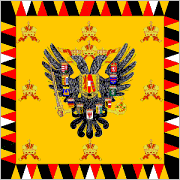
1848-1915
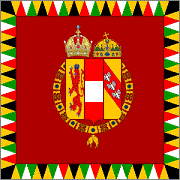
1915-18
ARMY RANK FLAGS • 1880-1915
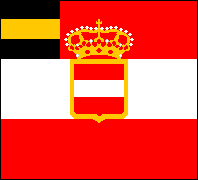
ALL GENERAL OFFICERS • 1867-80
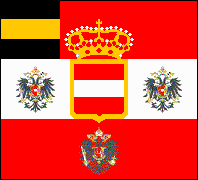
FIELD MARSHAL, CHIEF OF STAFF & COMMANDER-IN-CHIEF
Generalfeldmarschal, Chef des K.u.K Generalstab & Armeeoberkommandant
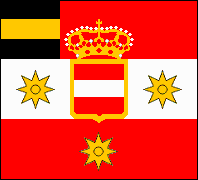
GENERAL • General der Waffengatung
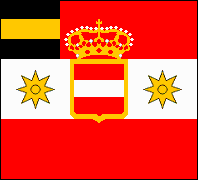
LIEUTENANT-GENERAL • Feldmarschalleutnant
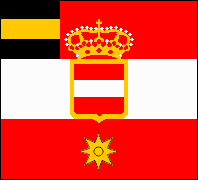
MAJOR-GENERAL • Generalmajor